Immediate Effects of Prescribed Fire on Sub-Surface Water Quality in a Managed Yellow Pine Forest
Abstract
1. Introduction
2. Materials and Methods
2.1. Site Description
2.2. Study Design and Data Collection
2.3. Statistical Analyses
3. Results
3.1. NO3-
3.2. NH4+
3.3. PO43-
3.4. pH
4. Discussion
4.1. Fire Effects on NO3-
4.2. Fire Effects on NH4+
4.3. Fire Effects on PO43-
5. Conclusions
Author Contributions
Funding
Conflicts of Interest
References
- Melvin, M.A. Prescribed Fire Use Survey Report. In National Prescribed Fire Use Survey Report; Coalition of Prescribed Fire Councils Inc.: Asheville, NC, USA, 2018. [Google Scholar]
- Hallema, D.W.; Sun, G.; Caldwell, P.V.; Norman, S.P.; Cohen, E.C.; Liu, Y.; Bladon, K.D.; McNulty, S.G. Burned forests impact water supplies. Nat. Commun. 2018, 9, 1–8. [Google Scholar] [CrossRef] [PubMed]
- Certini, G. Effects of fire on properties of forest soils: A review. Oecologia 2005, 143, 1–10. [Google Scholar] [CrossRef] [PubMed]
- Nowacki, G.J.; Abrams, M.D. The Demise of Fire and “Mesophication” of Forests in the Eastern United States. Bioscience 2008, 58, 123–138. [Google Scholar] [CrossRef]
- Elliott, K.J.; Vose, J.M. Initial Effects of Prescribed Fire on Quality of Soil Solution and Streamwater in the Southern Appalachian Mountains. South. J. Appl. For. 2005, 29, 5–15. [Google Scholar] [CrossRef]
- Van Lear, D.H.; Waldrop, T.A. History, Uses, and Effects of Fire in the Appalachians; US Department of Agriculture: Asheville, NC, USA, 1989; p. 20.
- Grace, J.M.I. Forest Operations and Water Quality in the South. Am. Soc. Agric. Eng. 2005, 48, 871–880. [Google Scholar] [CrossRef]
- Cawson, J.G.; Sheridan, G.J.; Smith, H.G.; Lane, P.N.J. Surface runoff and erosion after prescribed burning and the effect of different fire regimes in forests and shrublands: A review. Int. J. Wildl. Fire 2012, 21, 857–872. [Google Scholar] [CrossRef]
- Wan, S.; Hui, D.; Luo, Y. Fire effects on nitrogen pools and dynamics in terrestrial ecosystems: A meta-analysis. Ecol. Appl. 2001, 11, 1349–1365. [Google Scholar] [CrossRef]
- Swift, L.W., Jr.; Elliott, K.; Ottmar, R.D.; Vihnanek, R.E. Site preparation burning to improve southern Appalachian pine - hardwood stands: Fire characteristics and soil erosion, moisture, and temperature. Can. J. For. Res. 1993, 23, 2242–2254. [Google Scholar] [CrossRef]
- Fenn, M.E.; Poth, M.A.; Aber, J.D.; Baron, J.S.; Bormann, B.T.; Johnson, D.W.; Lemly, A.D.; McNulty, S.G.; Ryan, D.F.; Stottlemyer, R. Nitrogen Excess in North American Ecosystems: Predisposing Factors, Ecosystem Responses, and Management Strategies. Ecol. Appl. 2014, 8, 706–733. [Google Scholar] [CrossRef]
- Richter, D.D.; Ralston, C.W.; Harms, W.R. Prescribed fire: Effects on water quality and forest nutrient cycling. Science 1982, 215, 661–663. [Google Scholar] [CrossRef]
- Schoch, P.; Binkley, D. Prescribed burning increased nitrogen availability in a mature loblolly pine stand. For. Ecol. Manag. 1986, 14, 13–22. [Google Scholar] [CrossRef]
- Knoepp, J.D.; Elliott, K.J.; Clinton, B.D.; Vose, J.M. Effects of prescribed fire in mixed oak forests of the southern Appalachians: Forest floor, soil, and soil solution nitrogen responses. J. Torrey Bot. Soc. 2009, 136, 380–391. [Google Scholar] [CrossRef]
- Knoepp, J.D.; Swank, W.T. Site prepartion burning to improve souther Appalachian pine-hardwood stands: Nitrogen responses in soil, soil water and streams. J. For. Restor. 1993, 23, 2263–2270. [Google Scholar]
- Liechty, H.O.; Hooper, J.J. Long-term effect of periodic fire on nutrient pools and soil chemistry in loblolly-shortleaf pine stands managed with single-tree selection. For. Ecol. Manag. 2016, 380, 252–260. [Google Scholar] [CrossRef]
- Son, J.; Kim, S.; Carlson, K.H. Effects of Wildfire on River Water Quality and Riverbed Sediment Phosphorus. Water Air Soil Pollut. 2015, 226, 26. [Google Scholar] [CrossRef]
- Djodjic, F.; Bo, K.; Bergstro, L. Phosphorus Leaching in Relation to Soil Type and Soil Phosphorus Content. J. Environ. Qual. Abstr. 2004, 684, 678–684. [Google Scholar] [CrossRef] [PubMed]
- Keeley, J.E. Fire intensity, fire severity and burn severity: A brief review and suggested usage. Int. J. Wildl. Fire 2009, 18, 116–126. [Google Scholar] [CrossRef]
- Ficken, C.D.; Wright, J.P. Contributions of microbial activity and ash deposition to post-fire nitrogen availability in a pine savanna. Biogeosciences 2017, 14, 241–255. [Google Scholar] [CrossRef]
- EPA. Aqautic Life Ambient Water Quality Criteria for Ammonia—Freshwater 2013; EPA: Washington, DC, USA, 2013.
- Ice, G.; Binkley, D. Forest Streamwater Concentrations of Nitrogen and Phosphorus. J. For. 2003, 101, 21–28. [Google Scholar]
- Binkley, D. Patterns and Processes of Variation in Nitrogen and Phosphorus Concentrations in Forested Streams; NCASI: Raleigh, NC, USA, 2001. [Google Scholar]
- Bêche, L.A.; Stephens, S.L.; Resh, V.H. Effects of prescribed fire on a Sierra Nevada (California, USA) stream and its riparian zone. For. Ecol. Manag. 2005, 218, 37–59. [Google Scholar] [CrossRef]
- Neary, D.G.; Ryan, K.C.; DeBano, L.F. Wildland Fire in Ecosystems, effects of fire on soil and water. USDA-FS Gen. Tech. Rep. 2005, 4, 250. [Google Scholar]
- United States Department of Agriculture. Soil Survey of Pickens County, South Carolina; United States Department of Agriculture: Washington, DC, USA, 1972.
- US EPA. Analytical Methods Approved for Drinking Water Compliance Monitoring of Inorganic Contaminants and Other Inorganic Constituents. Water 2019, 2, 1–56. [Google Scholar]
- Battle, J.; Golladay, S.W. Prescribed Fire’s Impact on Water Quality of Depressional Wetlands in Southwestern Georgia. Am. Midl. Nat. 2003, 150, 15–25. [Google Scholar] [CrossRef]
- Elliott, K.J.; Vose, J.M. Fire Effects on Water Quality: A Synthesis of Response Regulating Factors Among Contrasting Ecosystems. In Proceedings of the Second Interagency Conference on Research in the Watersheds, Otto, NC, USA, 16–18 May 2006. [Google Scholar]
- Douglass, J.E.; Van Lear, D. Prescribed Burning and Water Quality of Ephemeral Streams in the Piedmont of South Carolina. For. Sci. 1983, 29, 181–189. [Google Scholar]
- Binkley, D.; Ice, G.G.; Kaye, J.; Williams, C.A. Nitrogen and phosphorus concentrations in forest streams of the United States. J. Am. Water Resour. Assoc. 2004, 40, 1277–1291. [Google Scholar] [CrossRef]
- Clinton, B.D.; Vose, J.M.; Knoepp, J.D.; Elliott, K.J. Stream Nitrate Response to Different Burning Treatment in Southern Appalachian Forests. In Proceedings of Fire Conference 2000: The First National Congress on Fire Ecology, Prevention, and Management; Tall Timbers Research Station: Tallahassee, FL, USA, 2003. [Google Scholar]
- Debano, L.F. The role of fire and soil heating on water repellency in wildland environments: A review. J. Hydrol. 2000, 232, 195–206. [Google Scholar] [CrossRef]
- Weil, R.; Brady, N. The Nature and Properties of Soils, 15th ed.; Prentice Hall: Upper Saddle River, NJ, USA, 2017. [Google Scholar]
- Vose, J.M.; Laseter, S.H.; Sun, G.; Mcnulty, S.G. Stream Nitrogen Response to Fire in the Southeastern U.S. In Proceedings of the 3rd International Nitrogen Conference, Contributed Papers, Nanjing, China, 12–16 October 2004. [Google Scholar]
- Hahn, G.; Coates, T.A.; Latham, R.E. Prescribed fire effects on water quality and freshwater ecosystems in moist- temperate eastern North America. Nat. Areas J. 2018, 39, 46–57. [Google Scholar] [CrossRef]
- Brockway, D.G.; Lewis, C.E. Long-term effects of dormant-season prescribed fire on plant community diversity, structure and productivity in a longleaf pine wiregrass ecosystem. For. Ecol. Manag. 1997, 96, 167–183. [Google Scholar] [CrossRef]

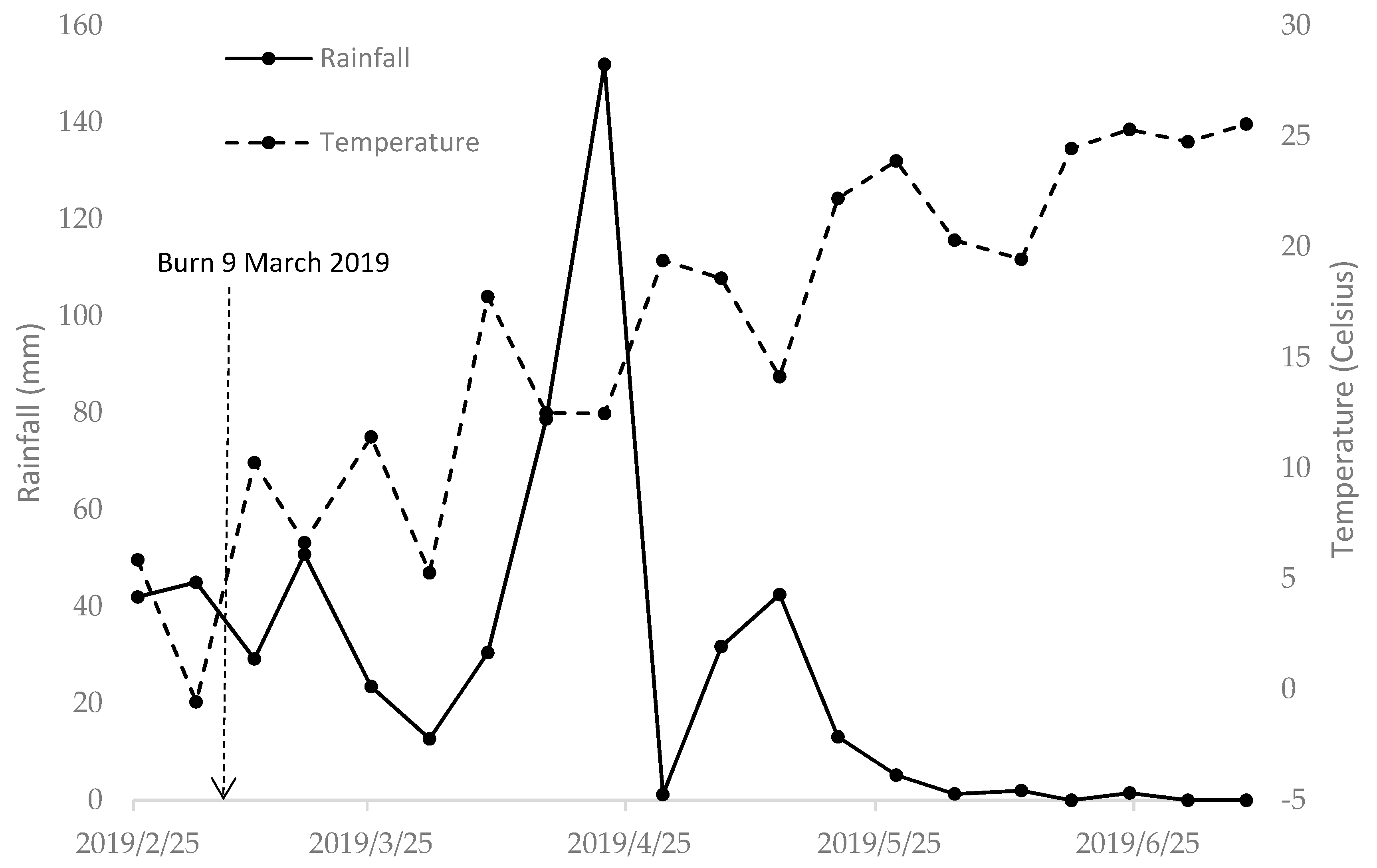
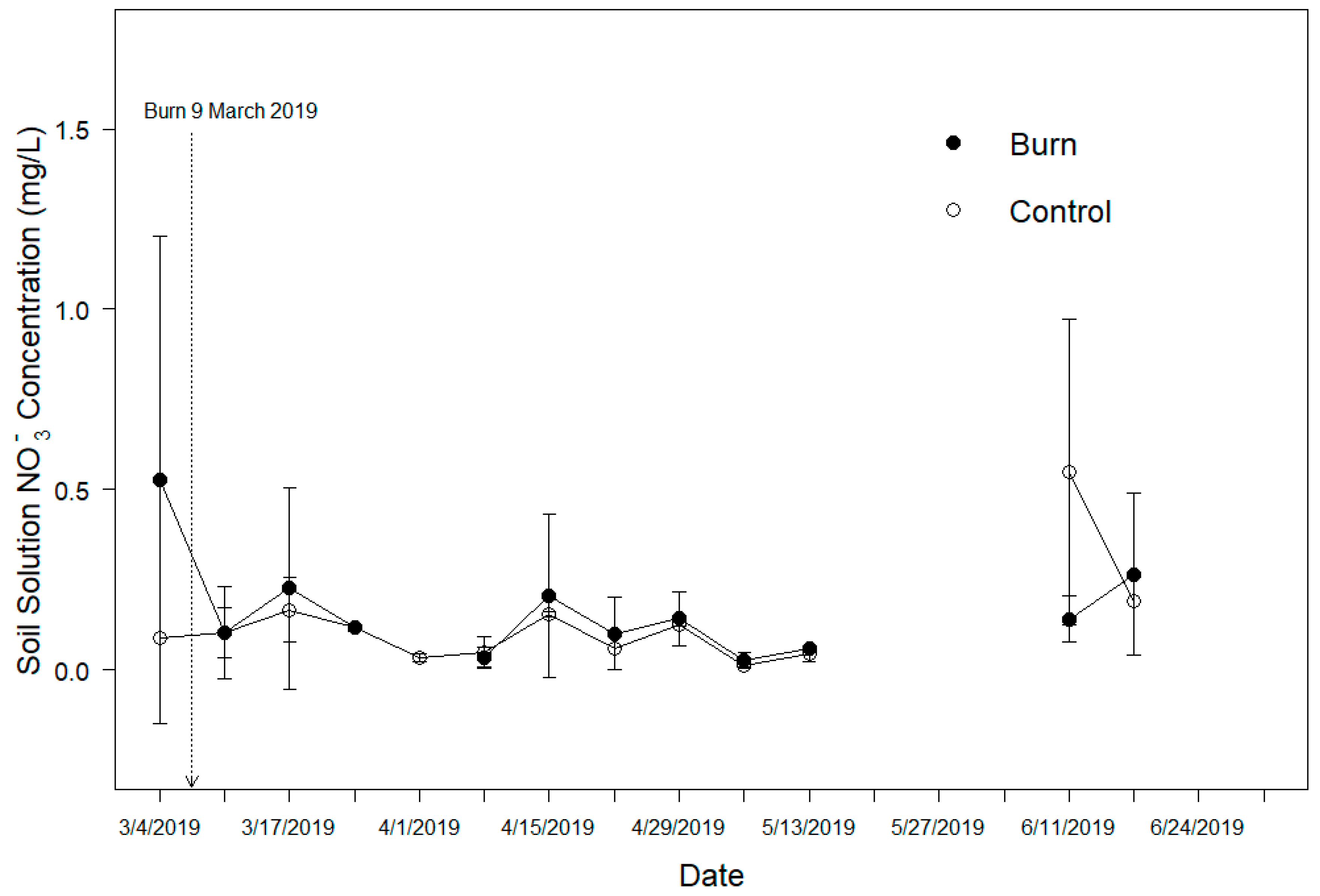
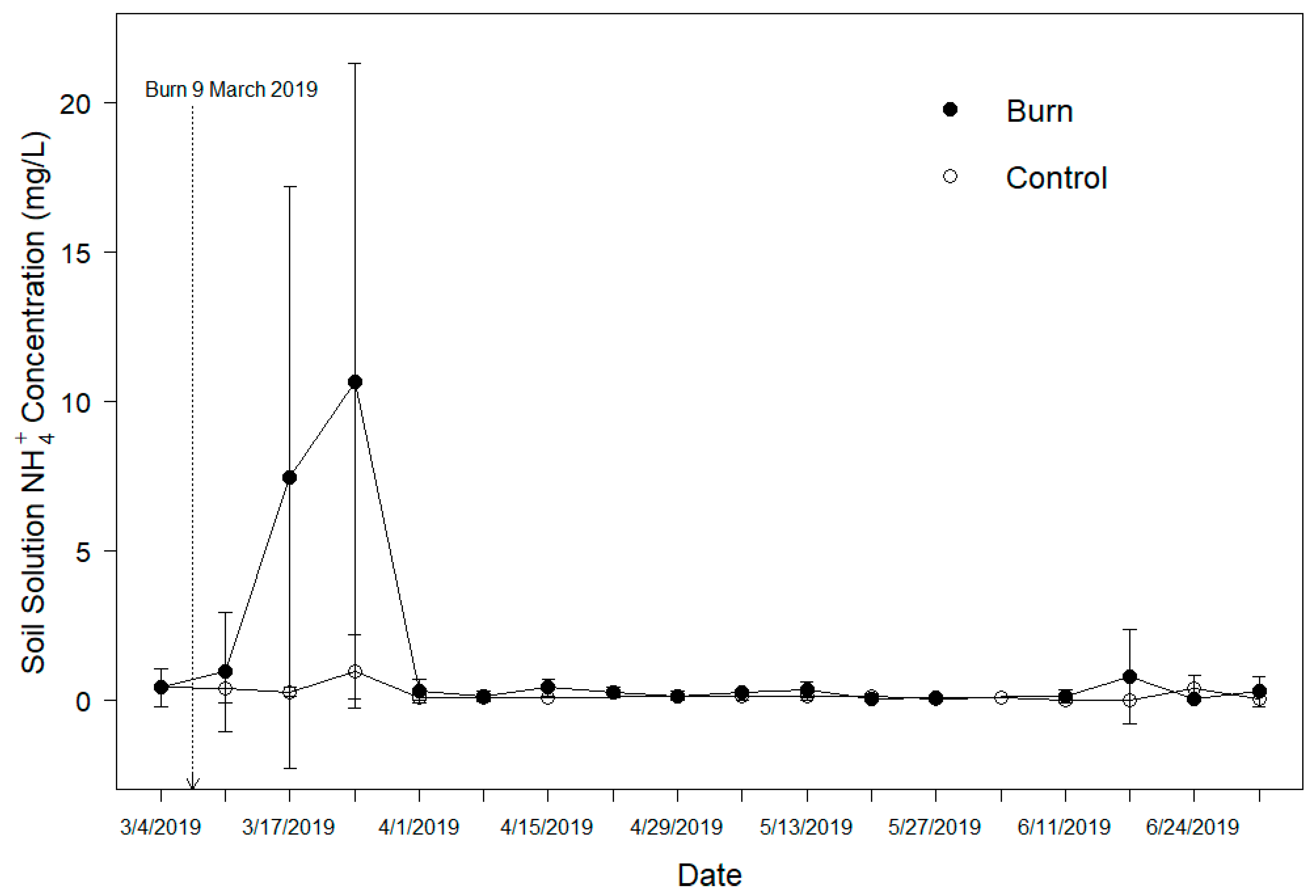
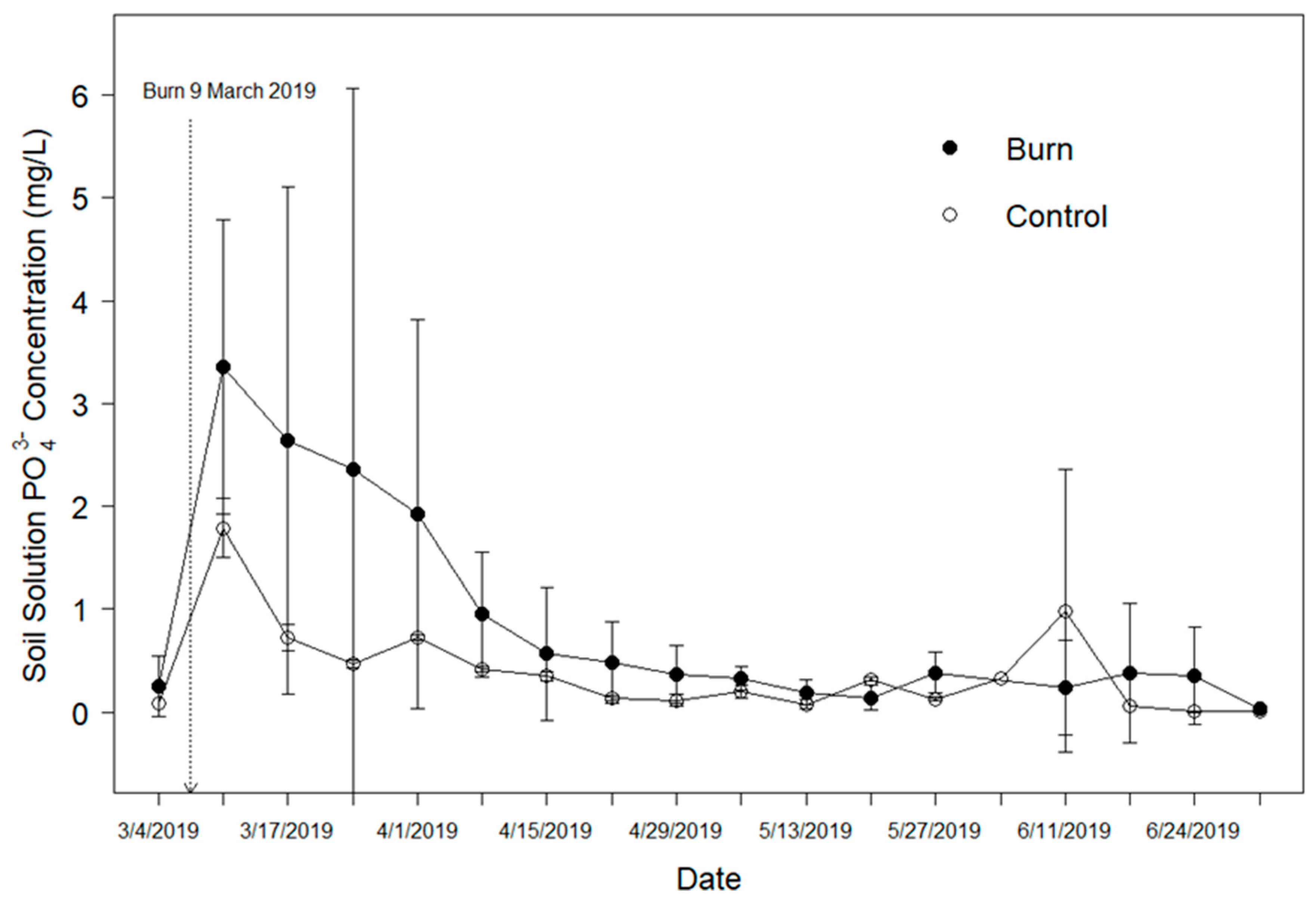
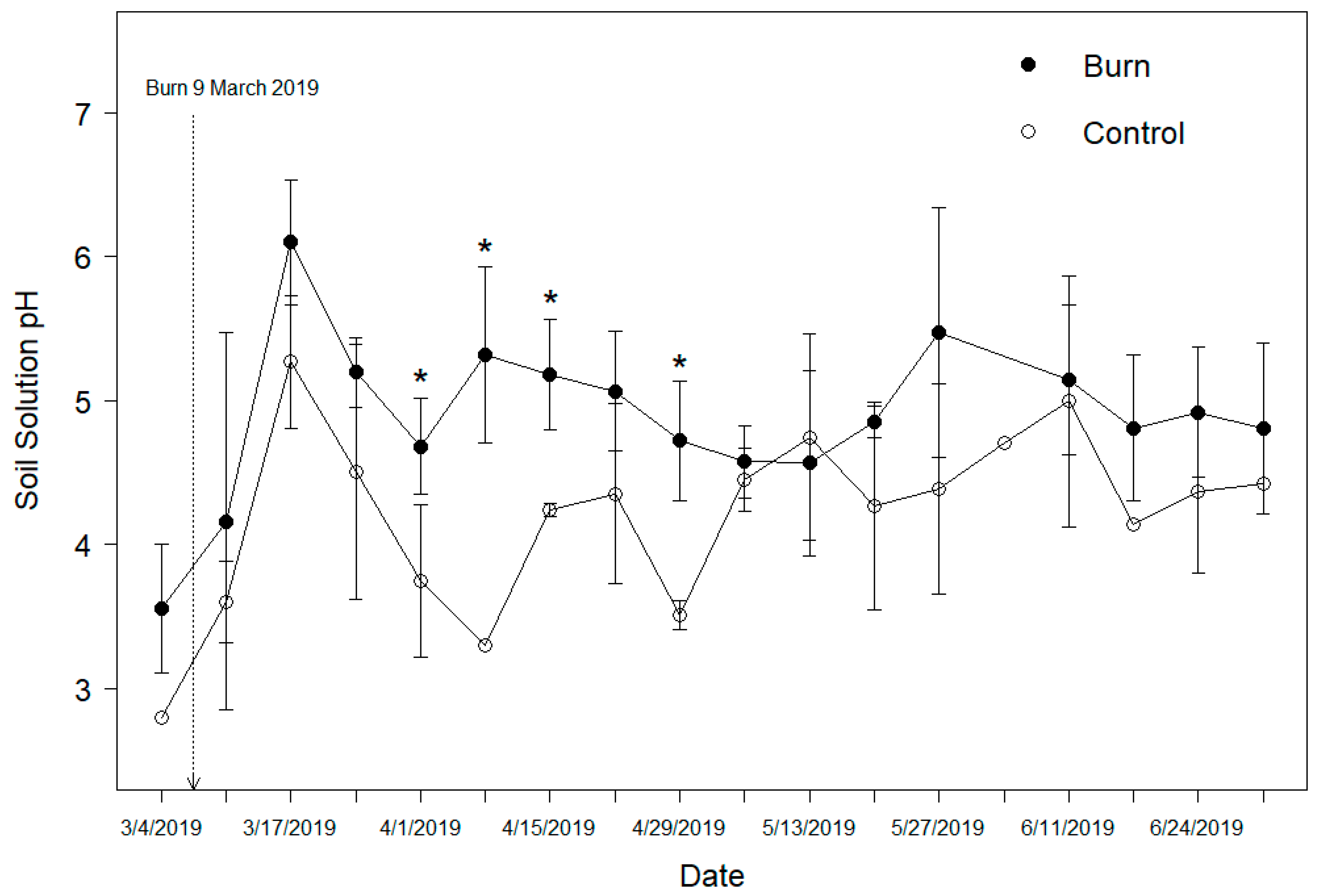
| Sample Type | pH | Total P (kg/ha) | TKN (ppm) |
|---|---|---|---|
| Soil | 5.0 (0) | 7.6 (2.4) | 0.6 (0.6) |
| Litter | 5.4 (0.4) | 8.9 (1.6) | 0.8 (0.06) |
| Parameter | Condition | PO43− | NO3− | NH4+ | pH |
|---|---|---|---|---|---|
| Maximum | Control | 1.90 (4.0) | 0.49 (0.33) | 1.37 (1.0) | 5.7 (0.07) |
| Burn | 6.57* (0.2) | 0.65 (0.36) | 18.02* (11.03) | 6.1 (0.3) | |
| Mean | Control | 0.53 (0.04) | 0.1 (0.04) | 0.21 (0.1) | 4.3 (0.01) |
| Burn | 1.55 (1.43) | 0.15 (0.07) | 2.48 (2.2) | 4.9* (0.01) |
© 2020 by the authors. Licensee MDPI, Basel, Switzerland. This article is an open access article distributed under the terms and conditions of the Creative Commons Attribution (CC BY) license (http://creativecommons.org/licenses/by/4.0/).
Share and Cite
Klimas, K.; Hiesl, P.; Hagan, D.; Park, D. Immediate Effects of Prescribed Fire on Sub-Surface Water Quality in a Managed Yellow Pine Forest. Fire 2020, 3, 14. https://doi.org/10.3390/fire3020014
Klimas K, Hiesl P, Hagan D, Park D. Immediate Effects of Prescribed Fire on Sub-Surface Water Quality in a Managed Yellow Pine Forest. Fire. 2020; 3(2):14. https://doi.org/10.3390/fire3020014
Chicago/Turabian StyleKlimas, Kipling, Patrick Hiesl, Donald Hagan, and Dara Park. 2020. "Immediate Effects of Prescribed Fire on Sub-Surface Water Quality in a Managed Yellow Pine Forest" Fire 3, no. 2: 14. https://doi.org/10.3390/fire3020014
APA StyleKlimas, K., Hiesl, P., Hagan, D., & Park, D. (2020). Immediate Effects of Prescribed Fire on Sub-Surface Water Quality in a Managed Yellow Pine Forest. Fire, 3(2), 14. https://doi.org/10.3390/fire3020014






